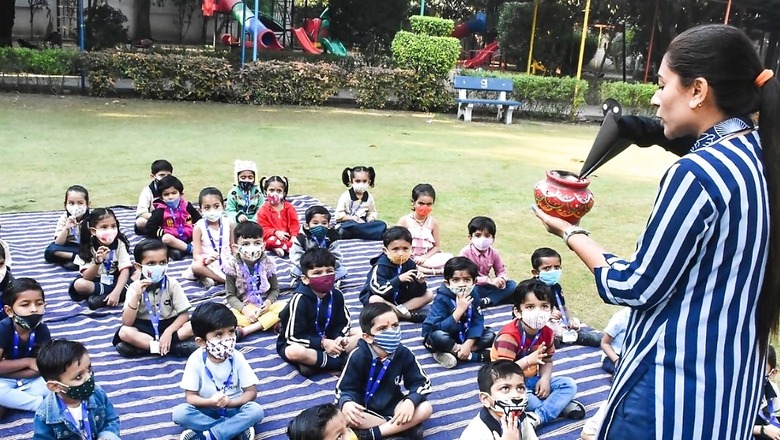
views
Little Seerat Naaz from the Lohai Malhar village in Jammu, urging the prime minister to build a nice school for them is indeed a defining moment for a developed India. As every survey is pointing out, our children’s learning (already poor) really suffered due to school closure during Covid. Studies also confirm how woefully inadequate online learning was in the absence of phones, tablets and computers with most children. Innovations by a few teachers across the country by holding classes outside classrooms, use of the public address system, etc. proved inadequate as a system. While some resources have been released for improving schools, it is not enough. We have to transform the governance of well-funded schools by making them community institutions. We cannot have a corrupt minister minting money in appointing school teachers (like in West Bengal).
The greatest positive thing to happen after the distressing learning poverty was the opening of schools, the inter-mixing of children, the renewal of classroom learning, the presence of teachers, and the joy of learning. Teachers faced an uphill task of catching up on the learning losses. Many struggled to ensure learning and catch up. Loss of income drove more children to government schools. Parental motivation for children’s learning, however, still made households squeeze out money for private tuition on a very large scale. Compromising basic food intake, even the poor vote for education as the gateway to prosperity. A democracy cannot fail the aspirations of its deprived households; learning must be allowed to happen.
The burden of non-teaching responsibilities of teachers has been the subject matter of discussion for decades, but the policy has not seen the kind of response needed. Perhaps the fact that it does not affect the children of the policy-makers and politicians has made us accept occasional disruptions to learning as a necessity in government schools. It has not gone beyond declaring the intent of 200 days of teaching per year. During a season of elections, and census, one shudders to think how children will suffer as teachers would be, ‘reportedly’ on election/census duty for extended periods. Not every state is like Himachal Pradesh, where even a decade ago, parents would protest school closure and therefore, teachers on election duty shut down schools only on voting day. In many other states, it becomes a time for teachers to be busy with training, material collection, and so on. Bihar is doing a caste census and this too is likely to disturb the school functioning. We must limit the school closure to not more than a couple of days for very necessary roles in elections/census. Make up by working over weekends. Transfer schools to community institutions with funds, functions and functionaries.
Add to these non-teaching duties, the management of the mid-day meal programme. Why cannot Panchayats and women self-help groups (SHGs) of the Livelihood Mission manage the mid-day meal and food at Anganwadis and leave teachers to teach and Sevikas to provide care and preschool learning? Why can we not provide a professional in a Panchayat (when we are talking of job creation) for all the Census and surveys that are carried out by teachers, disturbing their primary responsibility of teaching? Non-teaching responsibilities should be with Panchayats. Strengthen them with a community cadre of human resources to do that. The Community Resource Person (CRP) model of the Rural Livelihood Mission is appropriate. Human capital development cannot be sacrificed and therefore, teachers must be insulated from non-teaching responsibilities.
The emergency of children not learning is threatening the demographic dividend. We will grow old before we become rich if we do not act immediately. All political parties must recognise the fundamental right of every child to have an opportunity for quality learning in schools. The Central, state, local governments must immediately ensure a basic minimum learning condition from this academic session itself for children up to the age of 14 years. With the Constitutional amendment to make elementary education a fundamental right, classification of education in the concurrent list, and the experience of the Sarva Shiksha Abhiyan, the Centre and states should settle for a 50-50 sharing over ten years of the additional funds that may be needed to create a minimum learning condition. These could also come through convergence at the Gram Panchayat/Urban local body. Ownership and accountability of schools must be with local community institutions.
Preschool matters. After making it an integral part of the foundational learning and development of a child, 3 years onwards, under the new National Education Policy 2020, we must provide for universal coverage of all children in the 3-14 age group with teachers, teaching-learning materials, learning spaces, technology-enabled learning opportunities, toys as learning materials, and so on. The Village Organisations of the SHGs in every village can be given the responsibility of managing programmes of Anganwadis and schools. Anganwadi can be better trained for preschool learning for positive outcomes. This needs to happen immediately and all political parties must affirm their commitment to the children of the poor who trek to government schools and Anganwadis with hope. Let democracy not fail them.
There must be a common minimum commitment from all governments at all levels for the following basic learning guarantee for 3-14 age children if India has to secure the demographic dividend. The following should be non-negotiable when schools re-open after the summer vacations. Transformation in foundational learning levels can come over a three-year period if the governance of schools is simultaneously improved with long tenures of the leadership team. They cannot remain state government schools. They have to become local community schools within the Constitutional framework of local governments.
First, improve access by improving physical, human and other learning support. Every school must have an adequate number of teachers by rationalisation/appointment. Every classroom must be made attractive by a Mission Kaya Kalpa (like UP, Delhi, Gujarat and Punjab). Funds have been provided in other states as well. This will happen if Panchayats are directly responsible for schools and Anganwadis with funds, functions and functionaries immediately (like Kerala and Gujarat). All children with teaching learning materials/textbooks, technology-enabled learning opportunities through tablets, phones and sound boxes. Panchayats to ensure adequate gadgets to harness online learning materials. Zero teacher vacancy policy. Authorise Panchayats to fill up all vacancies with Teacher Eligibility Test, and pass candidates on ad hoc basis till regular teacher joins (zero vacancy policy as followed in Kendriya Vidyalayas). Provision of Special Needs Teachers in every cluster to ensure learning by all divyang children with support for gadgets.
Second, improve the management of the school system. No teacher should be assigned any non-teaching responsibility with immediate effect. Under any circumstance, such duty should not disrupt learning by the closure of schools. A minimum of 250 working days must be ensured in schools per year. Hold additional working days for any closure. Women SHGs to take over mid-day meal responsibility with the oversight of Panchayat/Ward Samiti/School Management Committee. Teachers must be free from the Mid-day meal (as in Tamil Nadu). There should be quarterly Parents Teachers Association (PTA) meetings to share the progress of children. Ensure monthly sports and cultural events in every school. Provide all budgetary funds to schools through Panchayats. Provide for long tenures to educational administrators at block and district levels with clear deliverables. Make schools a community institution. Neither government nor private will succeed; we need community institutions which are funded by the state but are accountable to those it serves at the local level.
Third focus on learning outcomes and teacher development. Ensure periodic non-threatening, assessment of learning by third-party agencies/civil society organisations with capability. Train all teachers in the use of online materials as supplemental to regular classroom teaching. Promote community learning spaces by establishing Public Libraries (like Karnataka and Jamtara districts of Jharkhand). Periodic assessment of teachers to ensure that those not equipped to teach must be out of the system after being given multiple chances. Give thrust on making teacher development and excellence at cluster/block and district levels through professional partnerships. Provide for multi-medium blended learning as the way forward in all schools.
If we ensure what is spelt out above, we would save a generation from remaining unskilled wage labour. India must move up the skilling ladder and basic education is its foundation. All political parties with a commitment to democracy ought to adopt this citizen’s agenda. The poor are demanding better human development opportunities for all; education alone makes the difference between poverty and prosperity, inequality and inclusivity, deprivation and well-being. The Navodaya schools generate hope among the poor. We need a Navodaya-like inclusive approach to quality and excellence in each and every school in the country. We must not fail the aspirations of the deprived.
Amarjeet Sinha is a retired civil servant. The views are personal.
Read all the Latest Opinions here

















Comments
0 comment